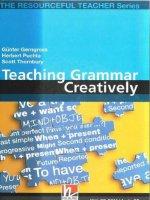Grammar sense 1 - from chapter 1 pps
Bạn đang xem bản rút gọn của tài liệu. Xem và tải ngay bản đầy đủ của tài liệu tại đây (85.3 KB, 6 trang )
CHAPTER 1: INTRODUCTION TO NOUNS
A. SINGULAR COUNT NOUNS:
Nouns are words we use for people, places, or things.
Use A, AN, THE before a singular count noun.
Use A before a singular count noun that begins with a consonant sound. Use AN before a
singular count noun that begins with a vowel sound (u e o a i).
Proper nouns (danh từ riêng) are names of specific people, places, or things. Proper nouns
begin with a capital letter (chữ cái Hoa). All other nouns are common nouns.
B. PLURAL COUNT NOUNS:
Add –s or –es the singular form of a regular count noun to make it plural.
THE or NO ARTICLE (không dùng mạo từ) can come before plural nouns. Don’t use A/
AN before plural nouns.
Use THE + a plural proper noun for the family name of two or more people.
For example: The Riveras The Sanchezes The Kims
Spelling of Regular plural Nouns:
+ For the most plural nouns, add –s to the base form.
Apple – apples lake – lakes flower – flowers river – rivers
+ If the base form ends with the letter s, z, ch, sh, x, add – es
Box – boxes bush – bushes fax – faxes watch – watches
+ If the base form ends with a consonant + y, change y to i and add – es.
(Compare vowel + y: boy – boys; toy – toys)
Baby – babies balcony – balconies dictionary – dictionaries
+ If the base form ends with a consonant + O, add –s or –es.
-s -es both – s and –es
Auto – autos potato – potatoes tornado – tornados / tornadoes
Photo – photos tomato – tomatoes volcano – volcanos / volcanoes
Piano – pianos zero – zeros/ zeroes
+ If the base form of certain nouns ends with a single f or fe, change f or fe to v and add – es.
Calf – calves shelf – shelves knife – knives
Exceptions: belief – beliefs, chief – chiefs, roof – roof, scarf – scarfs / scarves
Spelling of irregular plural Nouns:
Child – children goose – geese (những con ngỗng) person – people
Fish – fish man – men woman – women foot – feet
Mouse – mice tooth - teeth
C. PRONUNCIATION OF VERBS AND NOUNS ENDING IN – S / -ES:
1. If the base form of the noun ends with the letter (s, z, sh, ch, dge/ ge, x,) pronounce as /iz/
Slice – slices watch – watches price – prices inch – inches
Lose – loses judge – judges size – sizes language – languages
Wash – washes relax – relaxes dish – dishes tax – taxes
2. If the base form ends with the letter (p, t, k, f , gh), then pronounce /s/.
Sleep – sleeps work – work grape – grapes book – books
Hit – hits laugh – laughs cat – cats cuff - cuffs
3. If the base form ends with any other consonant or with a vowel sound, then pronounce /z/.
Name – names boy – boys
D. THE FUNCTIONS OF NOUNS:
Nouns as Subjects: We can use a noun (or pronoun) as the subject of a sentence. The
subject with BE tells who or what the sentence is about.
For example: 1. Barry King is the manager.
2. Computers are useful.
Nouns as Objects: We can use a noun as the object of a verb. The object usually
receives the action of the verb.
For example: 1. Call the manager. / 2. Please make the sandwiches now.
Nouns after BE (am, is, are): When a noun is used after BE, this noun is used to define
or describe the subject of the sentence.
For example: 1. A studio is a small apartment. / 2. The Freemans are teachers.
Nouns after Prepositions: After many prepositions, nouns refer to locations.
For example: 1. Mr. Clark is on the telephone. / 2. The school is in town.
3. Medford is near the city. / 4. Steve is from Boston.
CHAPTER 2: INTRODUCTION TO COUNT AND NONCOUNT NOUNS
COUNT NOUNS can be counted. They have both singular and plural forms. A, AN, THE,
A NUMBER (one, two…) can come before count nouns. The plural of a count noun is
usually formed by adding –S or –ES or have irregular plural forms.
+ Some count nouns have only a plural form. (jeans, clothes, scissors, sunglasses…)
+ Some count nouns have the same singular and plural form. (one fish – three fish; one
sheep – two sheep)
NONCOUNT NOUNS cannot be counted. They do not have plural forms. THE or NO
ARTICLES can come before noncount nouns, not A, AN, A NUMBER (one, two…).
+ Some noncount nouns end in –s, but they also take singular verbs.
For example: Economics is an interesting subject. / The news is not good.
* Some common noncount nouns:
+ Whole groups made up of similar items: baggage, clothing, furniture, equipment, food,
fruit, hardware, luggage, mail, makeup, money/cash/change, traffic…
+ FLUIDS: water, coffee, tea, milk, oil, soup, gasoline…
+ SOLIDS: ice, butter, cheese, gold, iron, glass, paper, wood, cotton…
+ GASES: air, oxygen, smoke, smog…
+ PARTICLES: rice, chalk, corn, dust, flour, grass, hair, pepper, salt, sand…
+ ABSTRACTIONS: beauty, courage, education, enjoyment, fun, happiness, health, help,
honesty, importance, peace, truth…
+ LANGUAGES: Chinese, English, Vietnamese…
+ FIELDS OF STUDY: chemistry, engineering, history, literature, psychology…
+ RECREATION: baseball, soccer, tennis, chess…
+ GENERAL ACTIVITIES: driving, studying, swimming, travelling, walking…
+ NATURAL PHENOMENA: weather, fog, heat, lightning, rain, thunder…
* GENERAL vs. INDIVIDUAL: Some nouns are both count and noncount. However, their
meanings are different. Count nouns refer to individual things. Noncount nouns are usually more
general.
For example:
Count (individual) Noncount (general)
1. Two large coffees, please (two cups of coffee) Don’t drink coffee. (the drink)
2. Give me the basketball. (the ball) Basketball is exciting. (the sport)
3. A lamb is a young sheep. (the animal) Lamb is good in stew. (the meat)
CHAPTER 3: DESCRIPTIVE ADJECTIVES
Adjectives describe nouns. Adjectives have only one form. Use the same adjective with
singular and plural nouns. (a friendly student, friendly students).
An adjective can occur alone after BE (am, is, are). When two adjectives come after BE,
separate them with AND.
For example: The apartment is bright and quiet.
When an adjectives comes before a singular noun, use A / AN before the adjective.
A new apartment an old apartment
Some nouns can function as adjectives when they describe other nouns.
A wedding dress a leather collar a wool hat a winter coat
ORDER OF ADJECTIVES:
Adjectives can describe many different features of a noun.
Quality/Opinion: comfortable, colorful Color: blue, gray
Size: large, small Origin: Chinese, Russian
Age: old, antique, young Material: wooden, cotton
Shape: round, square Kind/Purpose: riding, rocking
If two or more adjectives come before a noun, they usually follow this order:
quality/opinion, size, age, shape, color, origin, material, and kind/purpose.
Quality/ Size Age Shape Color Origin Material Kind/
Opinion Purpose
Beautiful tall old round blue Greek cotton racing
Expensive small new square green Italian wooden rocking
For example: 1. That’s an Italian racing bike.
2. They have a beautiful new rocking chair.
NOTE:
+ Adjectives can occur alone following stative verbs such as BE, BECOME, FEEL, SEEM,
LOOK, APPEAR
+ Some adjectives can’t come before a noun. (GLAD, PLEASED and certain adjectives
beginning with the letter A – awake, alone, asleep, afraid and alike.)
+ Some adjectives can ONLY come before a noun. (MAIN, CHIEF, PRINCIPAL, SAME,
ONLY, FUTURE, FORMER, PREVIOUS)
CHAPTER 4: POSSESSIVES AND DEMONSTRATIVES
A. POSSESSIVE NOUNS:
Use an apostrophe + -s ( ’s) after the singular nouns to form the possessive.
For singular nouns that end in – s, add an apostrophe alone or ’s.
For example: Marcus’ roommate (Marcus’s roommate)
For regular plural nouns, add an apostrophe alone (’) to form the possessive.
For example students’ teachers’
For irregular plural nouns, add ’s.
For example women’s children’s
For two or more nouns together, add ’s to the last noun.
For example Dan and Karen’s mother
Possessive nouns usually come before another noun.
B. POSSESSIVE ADJECTIVES: Possessive adjectives always come before nouns. Possessive
adjectives replace possessive nouns.
Subject Pronouns Possessive Adjectives POSSESSIVE PRONOUNS
I MY MINE
YOU YOUR YOURS
HE HIS HIS
SHE HER HERS
IT ITS ITS
WE OUR OURS
YOU YOUR YOURS
THEY THEIR THEIRS
C. Questions with WHOSE: ANSWERS
WHOSE + NOUN……?
Whose car is new? Joe’s
Joe’s car is new
Whose grades are good? Tom’s grades are good.
* FUNCTIONS:
+ Possessive nouns, adjectives, and pronouns show that someone owns or possesses something.
Erica’s car is old. Her car is old. Hers is old.
+ Possessives show human relationships.
Yuki’s mother is a doctor. Their mother is a teacher Mine is a nurse.
+ Possessives show physical characteristics.
Paul’s hair is wavy. My hair is black. Hers is brown.
D. DEMONSTRATIVE ADJECTIVES AND PRONOUNS (THIS, THAT, THESE, THOSE):
used to identify people and things for a listener. THIS/THESE refer to people or things that are
near the speaker. THAT/THOSE refer to people or things that are far away.
For example:
1. This shirt is fine, but these pants are dirty.
2. A: Look at that star!
B: That’s not a star.
3. Those desks are new.
4. This / That is new. (These / Those are new.)









